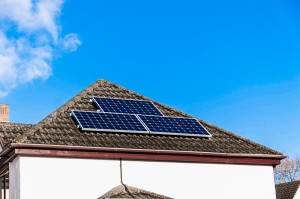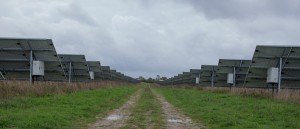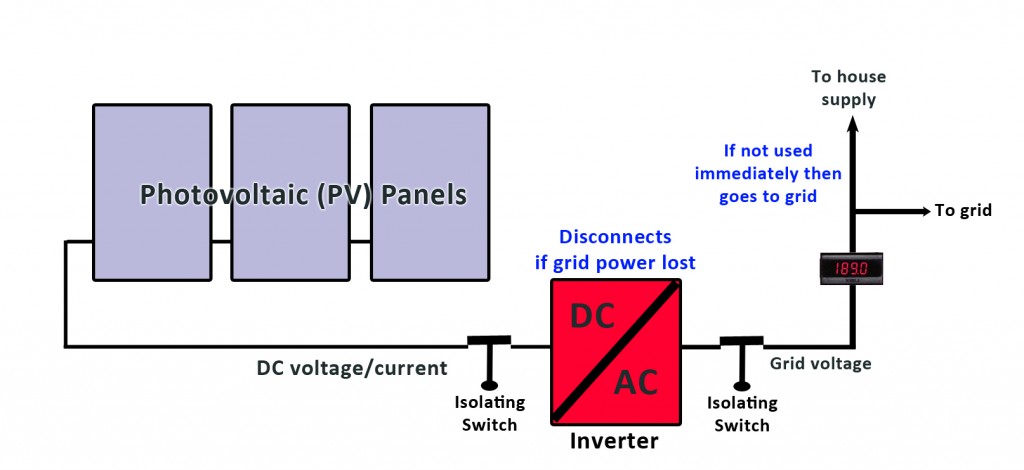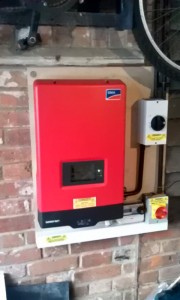Recently it has become increasingly affordable for home owners to fit Solar PV panels to the roof of their house and generate their own electricity.
Solar Panels

Solar panels generate electricity by using chemical reactions to convert the energy in sunlight (actually daylight) into an electrical current. A solar panel consists of many solar cells all joined together. A typical single panel generates around 200W peak, meaning that when it is exposed to full, unfiltered sunlight, it will produce about 200W (Watt) of power. That would be enough to power three 60W light bulbs.
This power is generated in the form of DC (direct current) power. As produced, houses cannot use this output as houses are wired for AC power (alternating current) so an inverter is necessary (see below).
When the sunlight is filtered by haze or cloud, the output of the panels reduces and at a certain level of light, the panel cuts off and produces no power.
A typical house might use 10-15kWh (Kilowatt Hour) a day – a kWh is the equivalent of using 1kW (Kilowatt) for 1 hour. So, in order to generate enough electricity for a house to benefit, several PV panels are installed and strung together so that their output is combined.
A typical installation might consist of 10 PV panels each producing 200W peak, thereby giving a combined output of 2000W or 2kW. If the systems produced this peak of 2kW for say, 6 hours, that would total 12kWh. In practice of course, the sunlight’s strength varies during the day and actual production is less than this.

Commercial installations can consist of many hundreds or even thousands of PV panels and generate several Megawatts of electricity.
The theoretical maximum output of the panels is almost never achieved, since the strength and angle of the sun, shading from other structures, clouds, haze, temperature and dust on the panels all reduce their output. The ambient temperature, for instance, affects output of the panels, so that if the temperature is high, output is reduced. The ideal day for generation is a crystal clear sunny day with no clouds, clean panels and an ambient temperature of around 15 Deg. C.

Inverter

Because solar panels produce direct current electricity, this is not usable by a house, which uses AC electricity (in the UK this is 230V AC). Therefore it is necessary to convert the DC electricity to AC electricity and this is done by an inverter.
The inverter will be sized so that it is most efficient in the range of output expected from the panels. It is not a “one size fits all” piece of equipment. Inverters need a minimum input from the panels to produce anything at all, and will have a maximum possible output. This maximum may be lower than the theoretical maximum of the panels, because over all expected conditions, this may prove more efficient and produce more overall output, than an inverter that can cope with the theoretical maximum but that may be less efficient at lower power.
Metering
On the output of the inverter there will be a meter which will count the amount of kWh generated by the inverter. On some systems, there will also be a meter to count how much electricity is sent out to the grid, rather than be used by the house. This is called an Export Meter. In the UK, an Export Meter is rarely fitted and the electricity companies tend to simply estimate that 50% of the generated power is exported to the grid.
Grid Safety
In the UK, if the mains power to a house is lost for some reason, it is not permitted to allow the solar PV to supply electricity to the house or the grid for safety reasons. Therefore there will be switching installed within the inverter to cut output should mains power fail.
There will also be isolating switches on both the DC and the AC side of the inverter so that the system can be made safe to work on.
Costs and Income
As of 2014, in the UK, a typical 4kW system will cost £5000 – £8000 (6000-9500EUR) installed. Once installed and working there are various ways in which the home owner could benefit.
Using the electricity generated – during daylight hours all the needs of the house, e.g. running the boiler, lighting, dishwashing etc can use the generated electricity. If not enough is being generated, then the remainder will be taken from the grid and paid for in the normal way. However if the house requirements are less than the power being generated by the solar PV then there will be no electricity charges for the usage. When the solar PV is generating some amount of power, household electricity bills will be reduced.
Feed In Tariff – in some countries, or in some regions of some countries, the government has offered incentives to encourage home owners to install solar PV. The feed in tariff or FIT, is paid to the home owner for every kWh generated by the solar PV system, regardless of whether the home owner uses the generated power or not. For some, this has resulted in a pay-back period of 5-8 years for the system.
Export payment – again, some countries or regions pay for each kWh exported to the national grid (i.e. not used in the house at the time it was generated), either metered by an export meter or estimated at a percentage of the generated amount.
